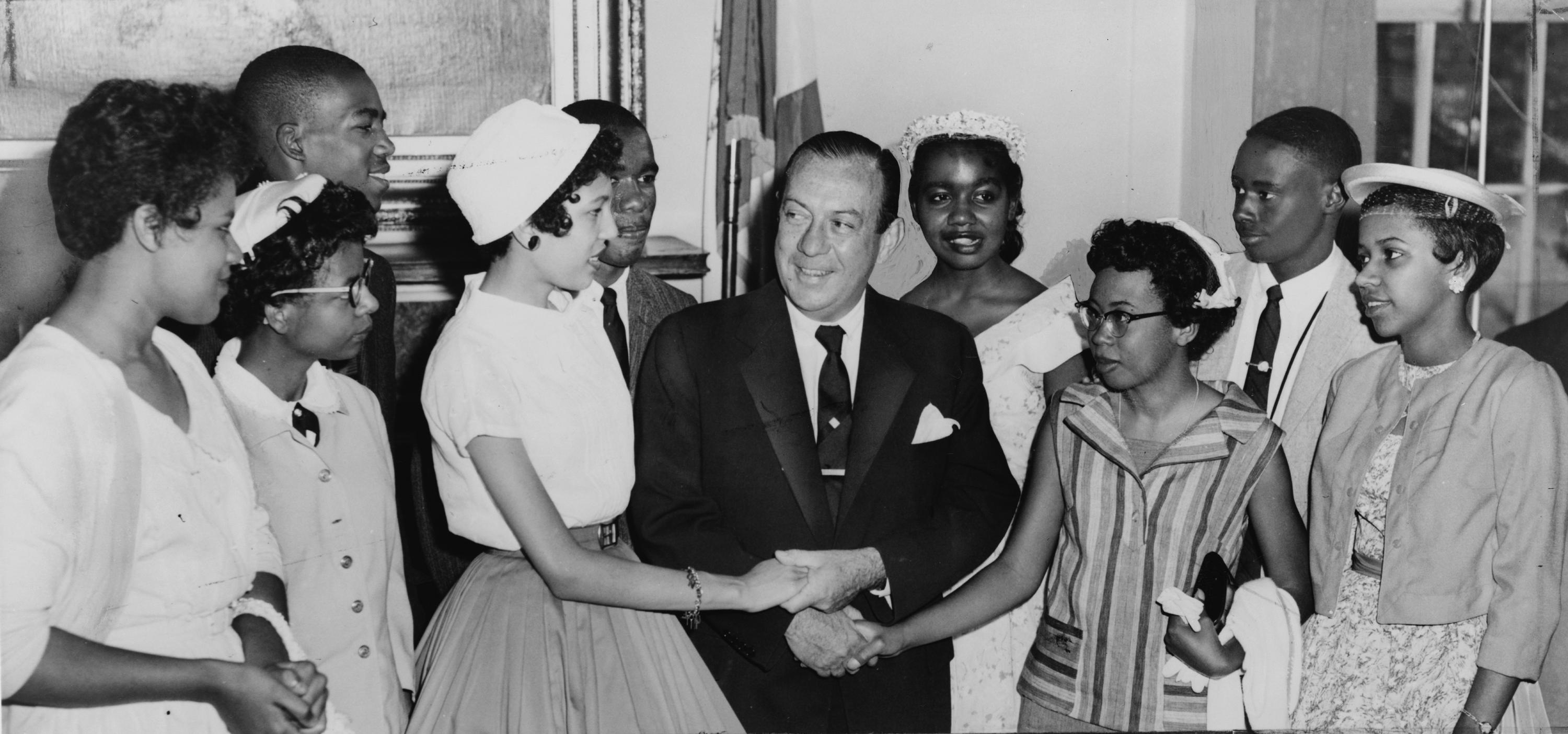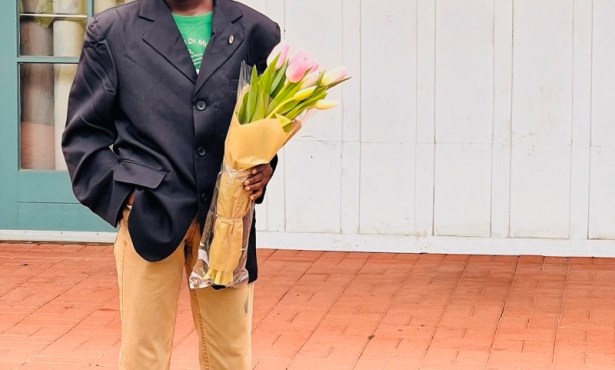Tall, Beautiful, and Proud: Minnijean Brown-Trickey
Member of the Little Rock Nine to Speak in UCSB Arts & Lectures’ Race to Justice Series


“We were under the delusion that we lived in the best place in the world,” said Minnijean Brown-Trickey, talking about her hometown, Little Rock, Arkansas, in the fateful summer of 1957. That was when she and eight other young African-American students performed an act of nearly unimaginable bravery. They chose to become the first Black students to integrate the then all-white Central High School. Since then, they have gone down in history as the Little Rock Nine.
In a recent phone conversation, Brown-Trickey, who will appear on Zoom this Friday, February 5, as a speaker in the outstanding UCSB Arts & Lectures series Race to Justice, told me about the history she and the others in her student cohort experienced, and about the perspective she brings to our challenging present moment.
In the weeks leading up to what would become a world-historical encounter with mob racism, Brown-Trickey told me that her teenage self was optimistic. “I couldn’t imagine that anyone could hate me; I thought that the other students at Central High would be just like me,” she said. “I thought racism was something that was owned by older people.”
She looked forward to going to a new school as an adventure, something interesting, and she assumed that with her noticeable poise and personality, white acceptance would follow, even if it took a few weeks or even a month.
Nothing could have been further from the truth.
In horrific scenes that were broadcast on national television and around the world, the nine young African-American students experienced an onslaught of racist shouts and were kicked at, spat on, and humiliated by an angry crowd of adults outside the school.
Eventually, then-President Dwight Eisenhower had to federalize the Arkansas National Guard so that Brown-Trickey and the eight other students could be safely escorted into the building. But once inside, the Little Rock Nine were again alone, facing assaults by the white students in the school halls and classrooms. For her and the other members of the nine, the daily ordeal of attending Central High became a relentless gauntlet of provocation and mistreatment.
Looking back on the experience today, she confessed to admiring the relatively innocent girl she once was before the school year began, and she laments what a gruesome reminder it was to watch the events that unfolded at the United States Capitol on January 6, 2021.
Seeing images on television of those white supremacists waving Confederate flags brought back fearful memories of what it was like to be a victim of racist mob violence. After the Capitol insurrection, when some people began to say, “We’re better than that,” Brown-Trickey was heartbroken when she had to acknowledge how untrue those words remain, saying over and over, “Not at all, not at all.”
As the target of nonstop harassment at Central High, Brown-Trickey learned to keep much of what she experienced to herself, concerned that it would add more worry to her parents, who were also suffering under a barrage of threats. A series of confrontations with white students bent on provoking a response led to the incident over which Brown-Trickey was expelled midway through the year. Although the school administration latched on to her use of the epithet “white trash” as the cause of her dismissal, Brown-Trickey sees this as a pretext. The real reason her presence at Central had become intolerable to authorities was the fact that she was “tall, beautiful, and proud.”
In the summer of 1957, before the school year began, Dr. Kenneth Clark visited Little Rock to meet and speak with the nine students who were about to integrate Central High. With his wife, Dr. Mamie Clark, he had provided the critical experimental research used by NAACP lawyers in Brown v. Board of Education that led to the Supreme Court’s 1954 historic ruling that resulted in the integration of Little Rock’s Central High.
Clark, who remained deeply interested in the impact of racism on human development, went to Arkansas to find out what facing intense white rage was doing to the Little Rock Nine. He must have seen something special in Minnijean Brown-Trickey, because four months later, after she was expelled from Central, Clark returned with an unexpected offer.
“Dr. Clark came to our house,” Brown-Trickey told me, “and he presented the idea to my parents that I should go back with him to New York City and attend an integrated private school that he and Dr. Mamie Clark were involved with, New Lincoln School.” Brown-Trickey’s mother deferred to her, saying that since she had been the one who decided to go to Central, she should be the one to decide about moving to New York City.
Though still a girl of 15, Brown-Trickey agreed to go to New York, and just a few weeks later she was in Manhattan, sharing a bedroom with the Clarks’ daughter, Kate, and attending a school that really was what she had dreamed Central High would be: integrated, academically challenging, and harmonious.
For Brown-Trickey, the brave stand she took in Little Rock became the opening act in a life dedicated to advancing social justice. After graduating from New Lincoln, she raised six children, eventually moving to Canada, where she discovered another community in which her indomitable spirit flourished, the Indigenous First Peoples of that country.
Although she began her academic career with the intention of pursuing a degree in social work, it was a new program in Indigenous social work that captured her imagination. One afternoon, as she was leaving what she described as a less-than-compelling course in mainstream education, she heard laughter coming from an adjacent classroom. Peeking in the door, she spied nine students — one white, and the rest Native Canadians. The decision to become the 10th student in that class was easy. As she recalls it, after hearing those voices, she said to herself, “Hell yeah, I’m doing that.”
Today she revels in the breadth of experience and friendship her years of social work among the Indigenous population of Canada has brought her. As one of her nieces said when attending her aunt’s annual Canada Day celebration: “This looks like the United Nations.”
Asked to reflect on the roles that political leaders sometimes play in stoking the fires of racism, Brown-Trickey said that, like disgraced former president Donald Trump, Orval Faubus, the racist governor who ruled Arkansas from 1955 to 1967, was engaged in “giving people permission” to express violent thoughts in action and offered whites “an incitement to be stupid and behave badly.” Although she declined to make any generalizations about such demagogues, Brown-Trickey observed that it is impossible to ignore how easily people can be manipulated.
Watching the January 6 insurrection, she thought about how people’s “brains can become locked in their thoughts.” Expressing her hope for a period of enlightenment following the shock of seeing such sights as a man parading through the Capitol with a Confederate flag, she said that Americans “may finally be learning a bit about not being exceptional.”
If there’s one subject about which Brown-Trickey remains stalwartly optimistic, it’s the role of future generations in the struggle for positive change. Asked if she felt that youth could become a factor in the pursuit of social justice, she was adamant, asserting that “young people have to lead” that movement. She thoroughly enjoys the contact she has with students and cites the more than 10,000 letters she has received from the children she has met over the years as evidence that “they are smarter even than we give them credit for.”
While they may regard her as “like their grandmother,” she feels that she enjoys a special connection to young people because she can still see herself as she was when she was 15. “I know what you are like because I know what I was like,” she tells them. Thinking about interacting with her favorite age group, 5th graders, Brown-Trickey grows warmly animated, praising the ways in which they are “open, and clear about what’s fair and what’s unfair” as well as their ability to “ask the best questions.”
In a conversation taking place under the shadow of so many dark uncertainties, talking about education feels like the presence of a ray of light. Remembering how she feels when she is among children, Brown-Trickey confides that “now I’m smiling. They’re the source of my optimism.” It’s not everything, but it is something.
411 | Minnijean Brown-Trickey will appear on Friday, February 5, on Zoom in conversation with Anne H. Charity-Hudley, the UC Santa Barbara North Hall Endowed Chair in the Linguistics of African America. Other upcoming speakers in the Race to Justice series include W. Kamau Bell on February 11; Dr. Mae Jemison on February 23; LaToya Ruby Frazier on February 25; and Michelle Alexander on March 4. All these events are at 5 p.m. For tickets and information, visit artsandlectures.ucsb.edu.




You must be logged in to post a comment.